–
Patterson Park is an absolutely beautiful 133 acre park located in southeast Baltimore. It is the oldest and one of the most historic parks in all of Baltimore City. The most iconic part of the park is its famed Pagoda – a three story observatory that sits atop historic Hampstead Hill. It is not uncommon to see pictures of the Pagoda used in a variety of different media, artwork and marketing materials.
Patterson Park is right in the middle of the dense neighborhoods of Canton, Butchers Hill, Upper Fells, Highlandtown and the Patterson Park Neighborhood. Being surrounded by these neighborhoods, Patterson Park is heavily used by the residents for a variety of activities including organized sports, festivals, small concerts and summer camps. The park is so popular it is often referred to as The Best Backyard in Baltimore. Given the importance of this park, a non-profit group was formed called the Friends of Patterson Park to help protect, promote and advocate for the park. The good work of the Friends of Patterson Park helps ensure that Patterson Park remains a treasured and well-maintained green space for future generations.
The park is divided into two main areas – the passive area and the active area. The passive area is contained on the western side of the park and includes walking paths, open lawns, historical elements and a pastoral setting. The active area of the park, on the other hand, is one the west side of the park and contains almost all the recreational amenities at Patterson Park. Surprisingly, although there are two distinct areas of the park, the park design integrates these two sections into one cohesive park.
LOCATION
Patterson Park is located in Southeast Baltimore. When using Google Maps, to get to the Northeast corner, you can use the Friends of Patterson Park’s address – 27 S. Patterson Park Avenue. This will get you to the historic part of the park near the Pagoda. The southeast corner off the park is located at the intersection of Eastern Avenue and Linwood and contains that active section of the park. This is typically where festivals take place and is near the ice rink, tennis court and ballfields.
The below picture snipped from Google Maps shows you the surrounding streets if you are trying to get to a specific section of the park.

BRIEF HISTORY OF PATTERSON PARK
The land on which Patterson Park sits is an important piece of land in Baltimore’s history. In 1814, as British troops burned Washington, D.C. and bombarded Fort McHenry, 100 cannons and 12,000 American soldiers occupied land that is now Patterson Park to repel an anticipated invasion by British troops. Seeing the armaments and men at Patterson Park, the British fled and Baltimore remained unoccupied.
Thirteen years later in 1827, six acres of the land used to repel the British were gifted to Baltimore by William Patterson to create a public walk. This walk was formally introduced as a public park in 1853 and named Patterson Park becoming Baltimore City’s first and oldest park. The park has had several additions over the years, with an additional twenty-nine acres purchased from the Patterson family in 1860. In 1873, Baltimore City annexed another 56 acres to add to the park and additions were made again in 1893 and 1910. In total, Patterson Park now has 133 acres.

During the Civil War, Patterson Park also served as a surgical hospital for union troops. The hospital was located just north of Lombard Street and Patterson Park Avenue and was called Camp Washburn. In 1864, the hospital and military buildings were demolished as the camp was disbanded.
In 1904, the famed landscape architecture firm operated by the Olmstead Brothers issued an extensive report regarding Baltimore City parks. In that report, the Olmstead Brothers recognized that Patterson Park was “immensely valuable” to the citizens who lived near the park and warned that the area surrounding Patterson Park was experiencing rapid development. To best serve the rapidly growing population, the Olmsteads suggested a substantial expansion of Patterson Park. In fact, they recommended adding space between Highland Avenue to the East extending down to Canton Square to the South. This addition would add 123 acres to Patterson Park and considering the rapidly approaching development, it was strongly urged that this expansion take place immediately. Unfortunately, the Olmstead’s recommendations were not heeded. Regardless, Patterson Park continues to be immensely important to the surrounding communities despite the fact that the density of the neighborhoods that surround Patterson Park makes Patterson Park a well used park.
For more details about the history of Patterson Park, see Tim Almaguer’s fantastic book – Baltimore’s Patterson Park.
AMENITIES
Patterson Park offers a lot of recreational and historic amenities spread over its 133 acres. It also has a number of buildings that have a variety of different uses. Each of the amenities and buildings are described below.
Recreational Amenities
1. Tennis Courts
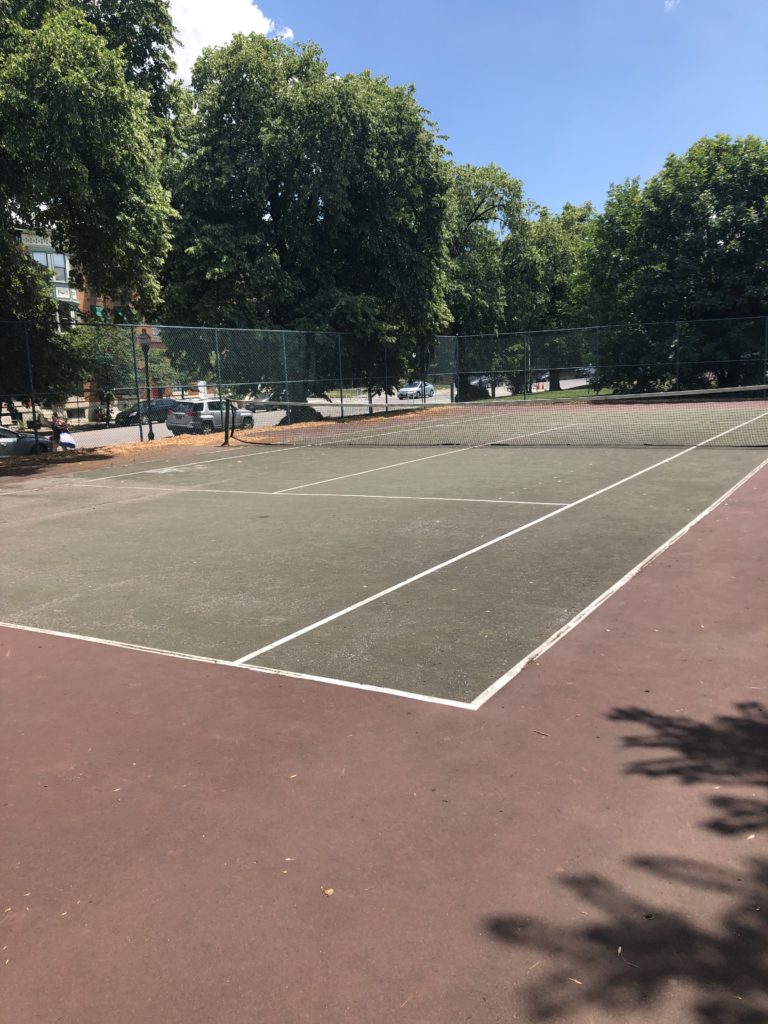
Located on S. Linwood Avenue at the intersection of E. Pratt St. The park has six tennis courts and two other courts that were converted to soccer and volleyball courts. Some of the surfaces are pristine, while others are just adequate. All courts are first come, first serve. In the past, the U.S. Tennis Association (“USTA”) and the Friends of Patterson Park have offered free lessons for children during the summer months. Check the Friends of Patterson Park website for details.
2. Swimming Pool and Splash Pad
The pool at Patterson Park is large and very popular during the summer months. The splash pad is also a good size for smaller children. The pool is located on the eastern end of Patterson Park and only allows for street parking. You will need to park somewhere near the intersection of E. Pratt Street and S. Linwood Avenue and walk into the interior of the park (it’s not far). The Patterson Park pool has some pretty restrictive rules on clothing, hours and the amount of time that can be spent at the pool, so make sure and check their website before heading over. Currently, a small fee of $2 is required to enter the pool.
3. Mimi DiPietro Ice Rink
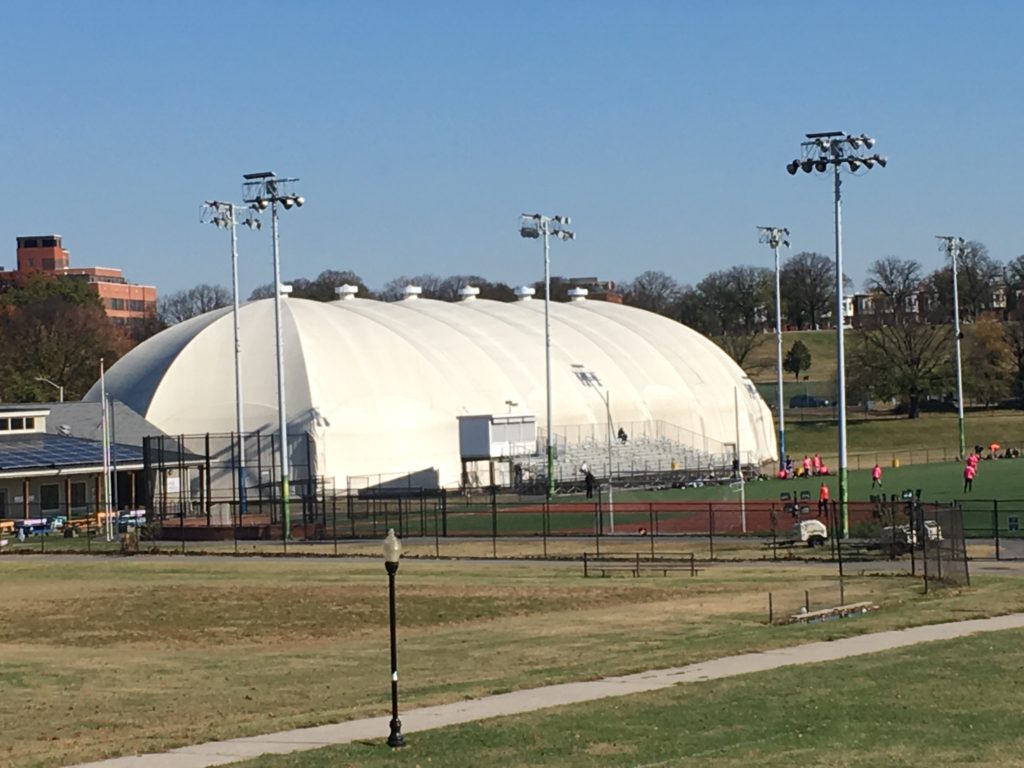
A unique feature at Patterson Park is a domed ice rink open during the cooler months. The ice rink is used for hockey, broom ball, and casual skating and can be rented for birthday parties and other events. Skates can be rented on site for a small fee. Be sure to check the ice rink’s website for hours because there is only limited availability for public skate sessions due to the popularity of the ice rink for hockey leagues. The ice rink is right next to the pool in the interior of the park and only allows for street parking. You will need to park somewhere near the intersection of E. Pratt Street and S. Linwood Avenue and walk into the interior of the park. Be aware – some people try to park next to the ice rink in a small parking lot on the interior of the park. This is for employees only and fines for parking inside the park without a permit are steep.
4. UTZ Twardowicz Field

UTZ field is made of synthetic turf that is used for a wide variety of organized sports from soccer to football to lacrosse. Its well maintained surface, stadium seating and lighting make it a great destination for larger sporting events.
5. Basketball Courts

A series of full-sized basketball courts are located on the interior of the park just to the north of the swimming pools. The courts are well-used in the summer months, and the court surfaces are pristine as of 2023. The backboards and rims are currently in fantastic shape. Courts are first come, first serve.
6. Baseball / Softball Fields
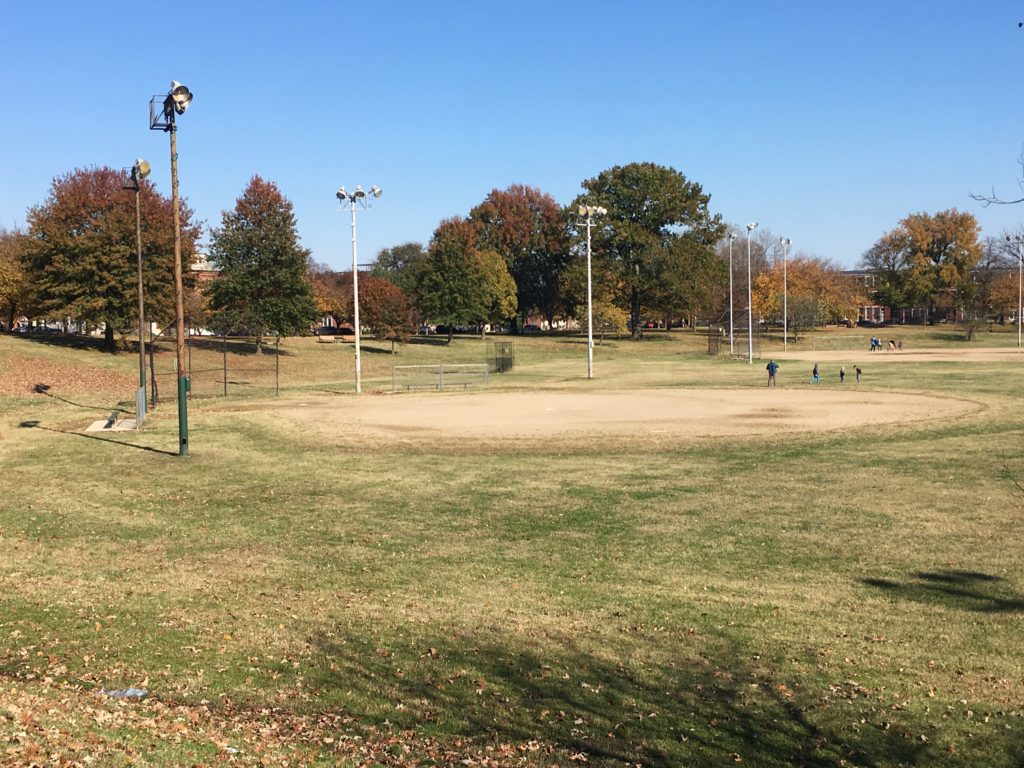
Patterson Park has a number of baseball and softball fields on the eastern side of the park and in what is commonly referred to as the park extension (which is located east of S. Linwood Avenue). These fields are used often by different recreation leagues and can be reserved through the Recreation and Parks Department. When not reserved, the fields are often used in a variety of different ways such as football or soccer or more casual sports such as frisbee or kickball.
7. Playgrounds
Two playgrounds are located at Patterson Park. The largest playground has slides, ramps, climbing poles and bridges all contained in two different fort like structures – one for toddlers and one for older children. This playground is located at Eastern Avenue and S. Milton Avenue. The surfaces for both fort like structures are wood chips and rubber matting.

The second playground is located just in the interior of the park at S. Linwood Avenue and E. Pratt Street. This playground contains a number of swings, slides, climbing poles and monkey bars with a wood chip surface. This is the only playground with swings.

Historic Amenities
1. Pagoda
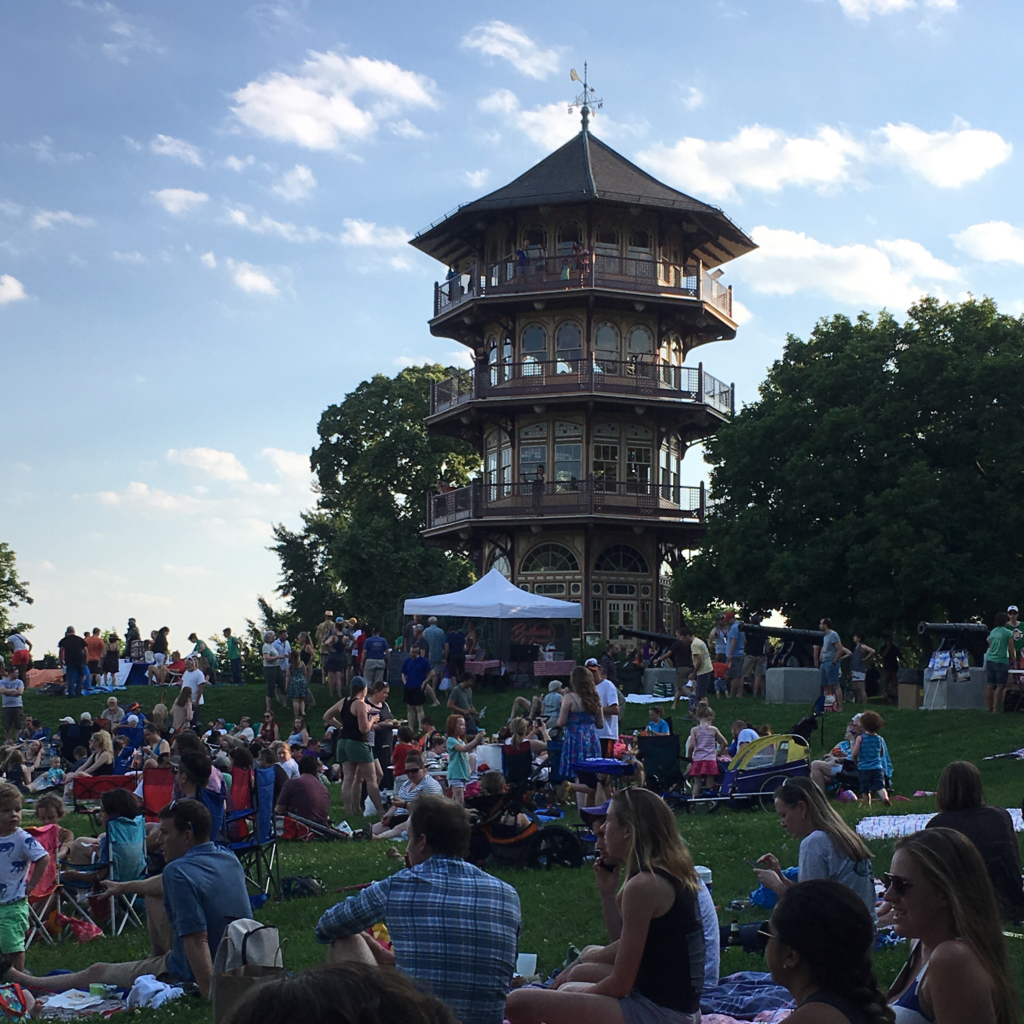
The most photographed part of Patterson Park is the Pagoda at Hampstead Hill. The Pagoda is located at Patterson Park Avenue and Pratt Street and is open to the public on Sundays from 12 to 6 p.m. (weather permitting) from the spring to the fall. The Pagoda’s interior consists almost entirely of a spiral staircase that leads to three levels of viewing decks at each level. It has some of the best views of the city and the park and is decorated in lights during the holiday season. Over the past several years, a new tradition of having a holiday event around the “Pagoda Lighting” has drawn a large amount of visitors. Details of the hours the Pagoda is open and when the Pagoda Lighting event will take place can be found at the Friends of Patterson Park’s website.
The history of the Pagoda and surrounding Hampstead Hill is laid out on signage both inside and outside the Pagoda and can be found here.
2. Fountain
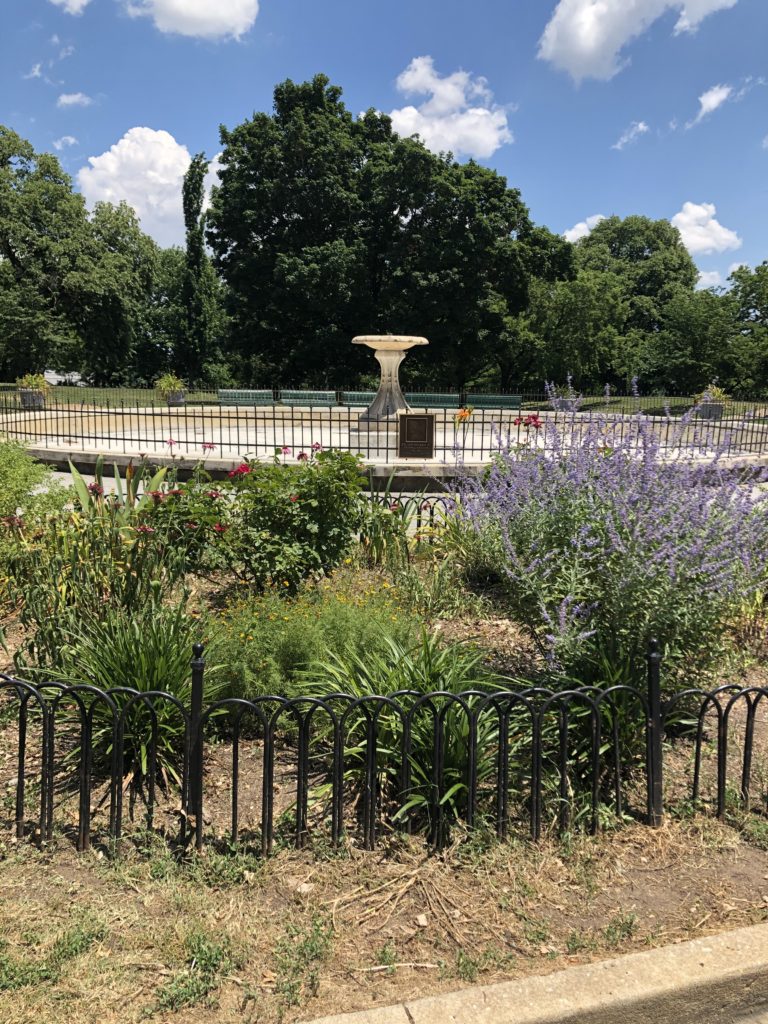
The oldest architectural feature at Patterson Park is the fountain, designed by George A. Frederick. The fountain was erected in 1865 and sits next to the White House. In the recent past, the fountain has undergone major maintenance issues and is slated for repair and renovation in 2020.
In 2015, the fountain was dedicated to Dr. Levi Watkins, Jr. – a great supporter of Patterson Park and a renowned cardiologist and civil rights activist.
3. Cannons at Hampstead Hill

The cannons at Hampstead Hill are a mix of different types of cannons made during different years and originating from different countries. The cannons are placed on Hampstead Hill in Patterson Park in the general area where cannons would have been placed at the park during the War of 1812. At one time, these cannons were used as curbs on Baltimore City streets. In 1907, some of the cannons made their way to Patterson Park. The Friends of Patterson Park recently had these cannons restored and new concrete bases made to preserve this piece of history.
4. Count Casimar Pulaski Monument
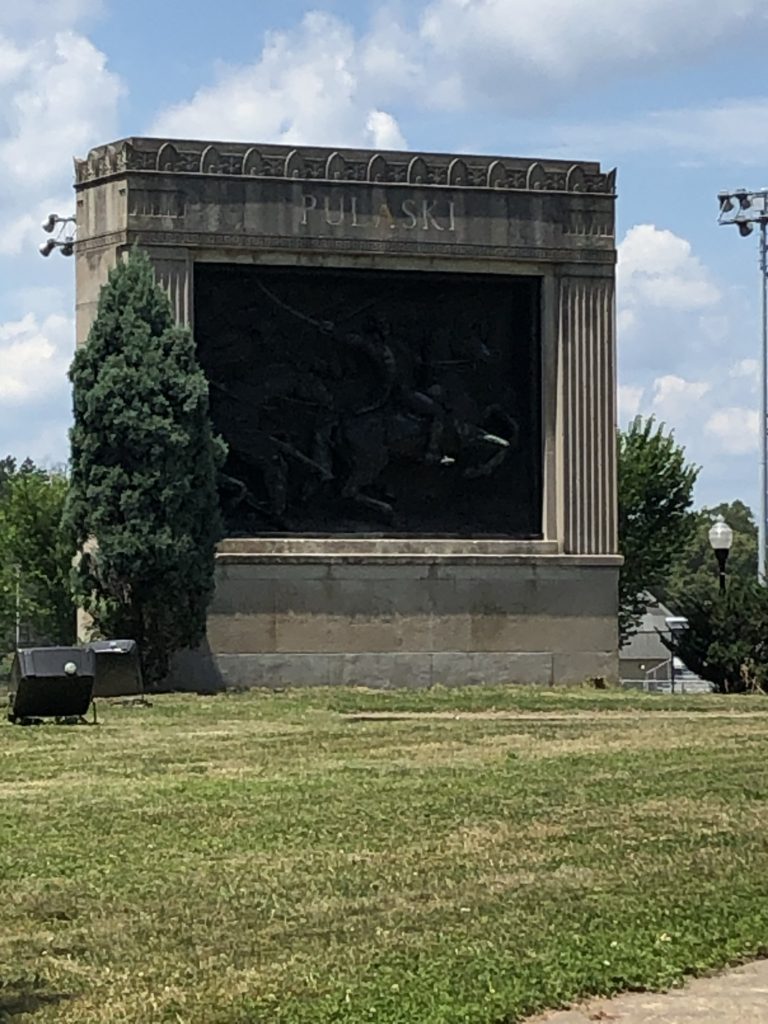
The Pulaski Monument is an absolutely gigantic concrete encased bronze relief sculpture of Count Casimar Pulaski – a Polish Revolutionary War hero. The sculpture was designed by Hans Schuler. Pulaski is considered the “Father of the American Cavlary” and he died during a cavalry charge in 1779. The sculpture depicts Pulaski aboard a horse in that battle. The monument was dedicated on October 14, 1951.
5. Statue to Commemorate the Writing of the Star Spangled Banner

According to Tim Almaguer’s book, Baltimore’s Patterson Park, the above statute is made of bronze and marble and was erected in 1914 to commemorate the writing of the star spangled banner. The statue was modeled after two children from the neighborhood and was sculpted by J. Maxwell Miller. You can find the statue on the west side of the Pagoda on Hampstead Hill.
6. Statue to Commemorate Song Award
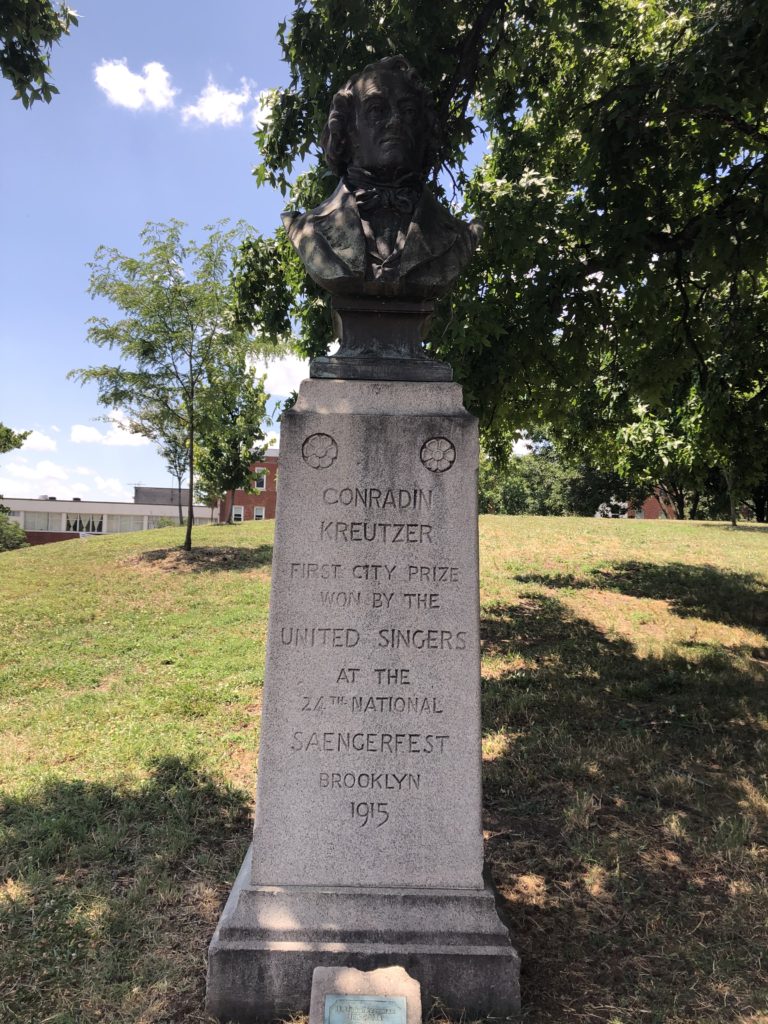
According to Tim Almaguer’s book, Baltimore’s Patterson Park one of the stranger monuments at Patterson Park memorializes the first place win of the United Singers of Baltimore at the National Saengerfest singing competition in Brooklyn, New York. The bust is of German composer Conradin Kreutzer.
7. The Mall

Stretching from the south side of the park to the north is the wide pathway referred to as “the Mall.” This was a copy of a promenade used at Central Park and when built, was lined with decorative urns containing floral displays. Today the Mall does not have decorative urns and the walkway is in need of some restoration, but it still serves as a wide open walking pathway that is heavily used.
Buildings at Patterson Park
1. Park Superintendent’s House / White House
On the northwest corner of the park at 27 S. Patterson Park Avenue is the old Park Superintendent’s House now commonly referred to as the White House. The White House was originally built in 1868 and housed Patterson Park’s Superintendent until some point in the 1970s. Since 1992, the White House has served as the office of the Friends of Patterson Park.
As of the summer of 2020, the White House is currently undergoing a massive renovation with hopes of turning the building into a visitor center and offering a better environment for the Friends of Patterson Park. Details of the construction plan can be found here. Current estimates have the completion of construction in September 2020.
2. John Booth / Hooper Senior Center a/k/a the Casino Building
2601-A East Baltimore St
Baltimore, Maryland 21224
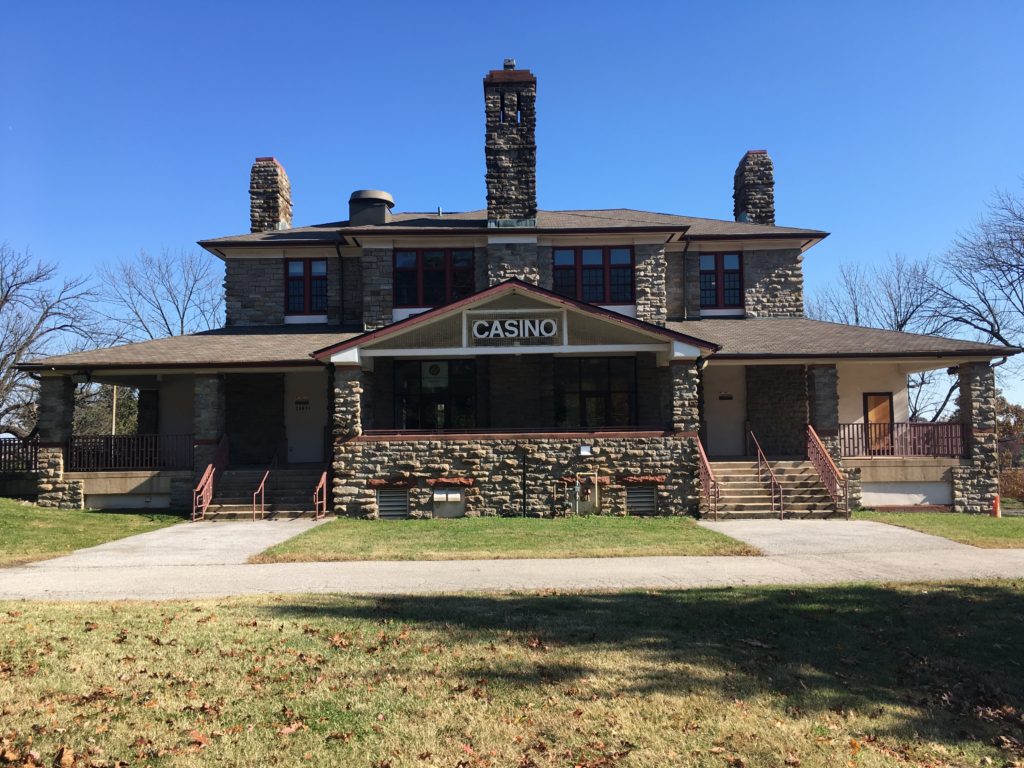
The John Booth / Hooper Senior Center is contained in a large mansion like structure that has a sign at its front entrance that says “Casino” – although the building was never a casino. Confused? Me too.
Currently the Baltimore City Department of Health uses this Casino building as a senior center called the John Booth / Hooper Senior Center. Despite the Baltimore St. address, the senior center is not actually on Baltimore Street, but is located in the interior of Patterson Park. Incredibly, a search for information about the services provided and hours of the John Booth / Hooper Senior Center was fruitless (which is pretty amazing that an entire senior center has no website indicating its hours or the activities that are scheduled for the facility). The only information I could locate is the contact information for the senior center’s manager. I would recommend calling or emailing if you would like more information.
Jacqueline Lofton, Center Manager
Phone: 410- 396-9202
Fax: 410-675-0383
Email: jacqueline.lofton@baltimorecity.gov
3. The Virginia S. Baker Recreation Center
2610 E. Baltimore St, Baltimore, MD 21224, (410) 396-9156
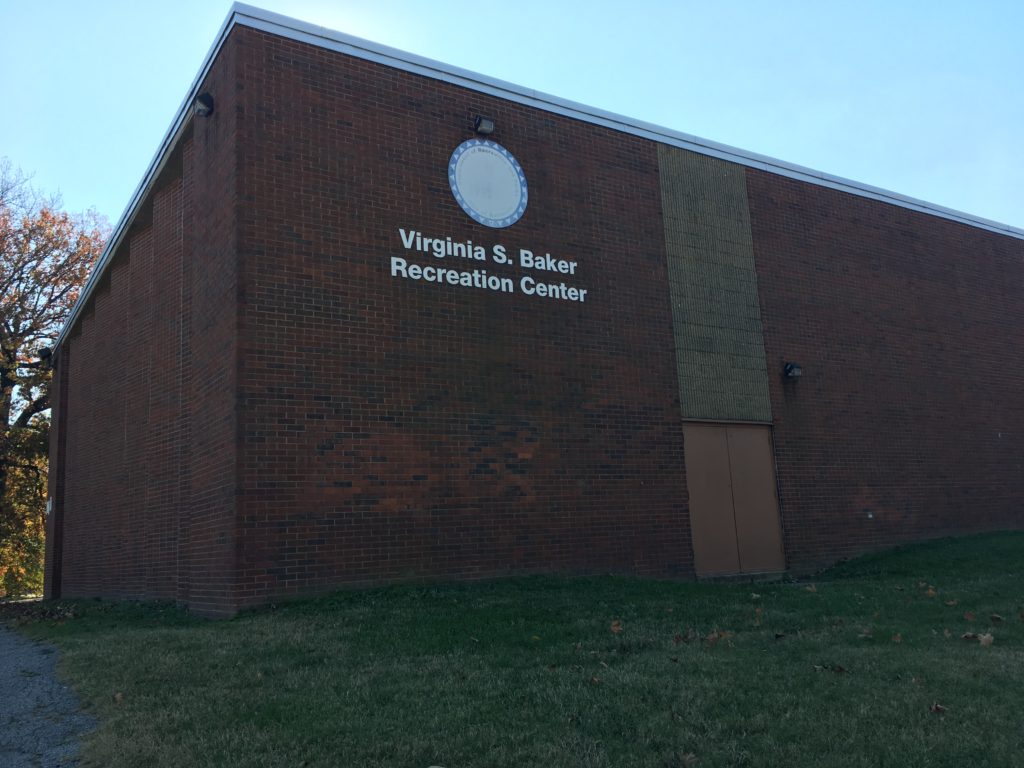
The Virginia S. Baker Recreation Center building is on the northern edge of Patterson Park. Unfortunately, there is very little information about the programs and events that take place at this recreation center and no information about the amenities available inside the building. The only website information I could locate was https://bcrp.baltimorecity.gov/recreationcenters#Virginia%20S%20Baker. This website does contain hours of service which is re-printed below.
Fall, Winter and Spring: 1-9 p.m.—Mondays and Wednesday through Friday; 10 a.m.-6 p.m.—Tuesdays.
Summer: 8 a.m.-8 p.m.—Monday through Friday.
During School Breaks: 11 a.m.-7 p.m.
Other Popular Amenities
1. Patterson Park Dog Park
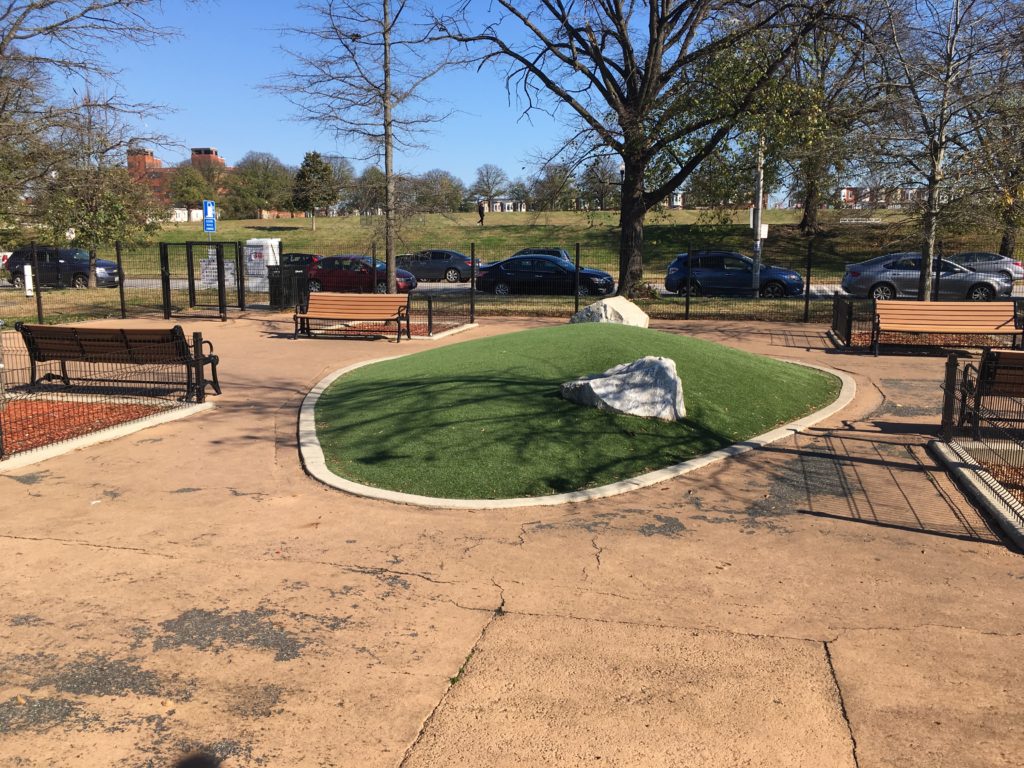
Located on S. Linwood Avenue near the intersection of Eastern Avenue are two small fenced dog parks – one for bigger dogs and one for smaller dogs. The dog park is covered in artificial grass with an undulating landscape for the dogs to play. The park also has a water source to keep dogs hydrated. As the dog parks are small, children are not permitted. There are additional rules for using the dog park as well. Those rules can be found at the Patterson Park Dog Park website.
2. Duck Pond
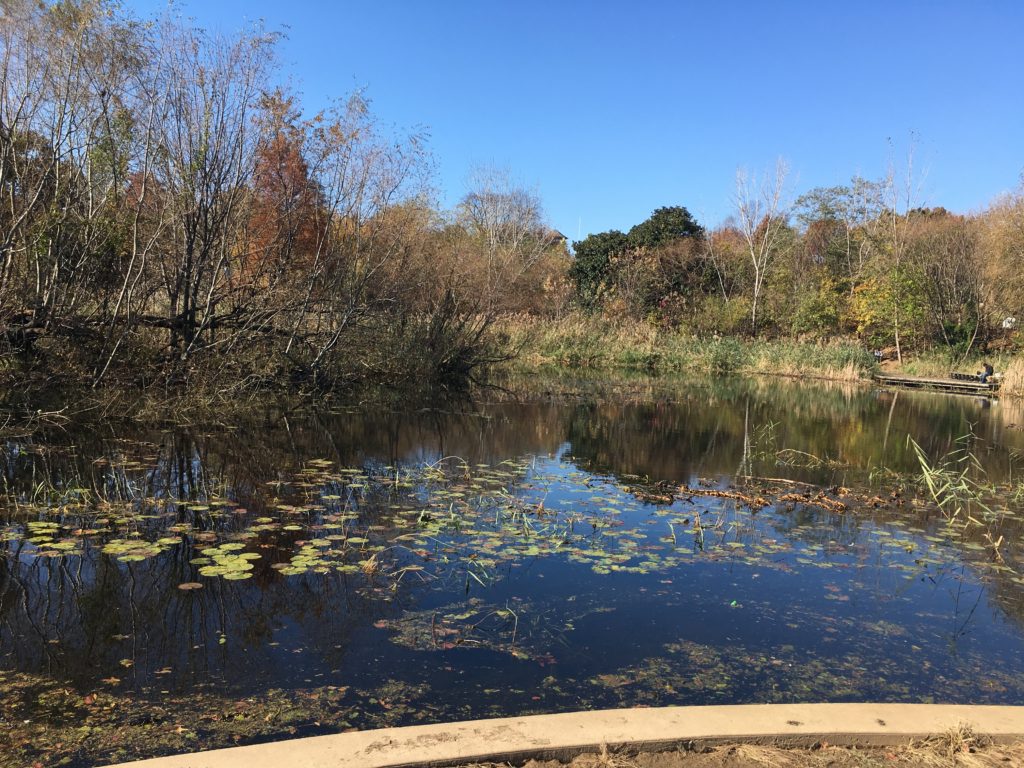
Patterson Park’s duck pond is located on the southwestern side of the park near Eastern Avenue and S. Rose St. The pond is stocked with fish in the summer months and is home to lots of different wildlife including ducks, frogs, turtles and a large variety of birds. The wildlife is so plentiful that Middleton Evans created a book called The Miracle Pond that set out some fantastic photos of the wildlife found in this small pond in the middle of an urban park.
3. Pavilions
Patterson Park is home to two large pavilions that can be rented for events or parties. The pavilions can be accessed by car, but does not allow parking inside the park except for set-up and tear down of the event. The rates and description of the pavilions for rent can be found here.
ANNUAL EVENTS AT PATTERSON PARK
Patterson Park hosts some of the most unique and quirky events in all of Baltimore. During the summer months, festivals and events are scheduled on most weekends. Below are just some examples of the popular events you will find at Patterson Park.
Hosted by the Creative Alliance and the Friends of Patterson Park, this event is centered around the annual parade of costumed participants carrying handmade lanterns along with creative costumes, marching bands and cheerleading squads from various local schools. Parade participants parade around the park pathways just after dark showing off their costumes and lanterns. Before and after the parade there is typically live music, food and drink vendors and art installations. In the weeks coming up to the event, the Creative Alliance offers workshops for children and adults to help make costumes and lighted pieces for the parade.
Kinetic Sculpture Race – One of the quirkier events in Baltimore, this event involves kinetic sculptures ridden by members of the community through different obstacles courses throughout the city. Two obstacles of this race typically take place at Patterson Park – the sand pit and the mud pit. This events is sponsored by the American Visionary Arts Museum with assistance from the Friends of Patterson Park. A truly unique event for both children, adults, artists and onlookers.
Pagoda Lighting – In December, Patterson Park’s famed Pagoda is decorated with lights and a celebration occurs to light the Pagoda for the first time. Santa Claus usually makes and appearance and he is sometimes accompanied by Mrs. Claus. Usually there is live music, food stalls and vendors selling gifts. This is a great event for children and adults with the entire program lasting about an hour. Be sure to check the Friends of Patterson Parks website for the date and time the event occurs.
Wine at Sunset – One of my favorite events is the Friends of Patterson Park’s annual wine testing event and fundraiser. The profits from this event support the work of the Friends of Patterson Park and is a great time to mix with those that live in the neighborhood and support the pari. This event is usually on a Thursday night during the spring and lasts a few hours. Your ticket allows you to sample different wines and bite sized food offered by a large variety of vendors. Some years there are also beers for tasting as well. The event also has live music and a silent auction allowing you to bid on a variety of items. Check with the Friends of Patterson Park for details on this annual event.
Dia del Nino – this free event usually occurs in the spring and has a large variety of activities for children. In past events there was pinatas, a booth for making paper airplanes, face painting and storytelling. It seems this event grows larger and becomes more popular every year. Check with the Friends of Patterson Park or the Creative Alliance for details.
FRIENDS OF PATTERSON PARK

The Friends of Patterson Park was created in 1998 as a result of Patterson Park’s first Master Plan. At the time, Patterson Park was in poor condition and the City needed support to help Patterson Park improve. The Friends of Patterson Park was created to “assist and work together with Baltimore City agencies to make Patterson Park the best park in the city.” In addition, the Friends envisioned “raising funds to support special projects for the park.”
Raising funds has been an important part of the Friends purpose in the intervening years. The Friends is funded largely through donations from individuals, companies and charitable foundations. These funds allow the Friends to employ three full-time employees and two part-time employees. These employees coordinate volunteer efforts, provide park programming, advocate on behalf of the park, fundraise and act as a liaison between the community and the City. Raised funds are also used to maintain historic structures and buy equipment for maintenance and park clean-up activities. If you are interest in donating to the Friends of Patterson Park, click here.
The Friends of Patterson Park is a great resource for anything pertaining to the park. If you have questions, stop by the office, take a look at their website or give them a call.
Friends of Patterson Park, 27 S. Patterson Park Avenue, (410) 276-3676
Website – www.pattersonpark.com
BOOKS AND ARTICLES ABOUT PATTERSON PARK
Patterson Park is a very popular subject for books and articles. Subjects range from photographic books, to books regarding the unique history of Patterson Park to journal articles about property values and crime related to Patterson Park. Below are links to just a few of these books and articles.
The Miracle Pond by Middleton Evans
The Best Backyard in Baltimore by Peter Harnick
Baltimore’s Patterson Park by Tim Almaguer
Creating a Special Benefits District for Baltimore’s Patterson Park by Scott Richmond
Property value, parks, and crime: A hedonic analysis in Baltimore, MD by A. Troy and JM Grove
Baltimore’s Historic Parks and Gardens by Eden Unger Bowditch
Air quality effects of urban trees and parks by David Novak and Gordon Heisler
PATTERSON PARK MASTER PLANS
For those that want a deep dive into Patterson Park, the park has two Master Plans which cover tons of material about the history of the park, the different amenities at Patterson Park and future recommendations about maintaining, managing and building at the park.
–
–
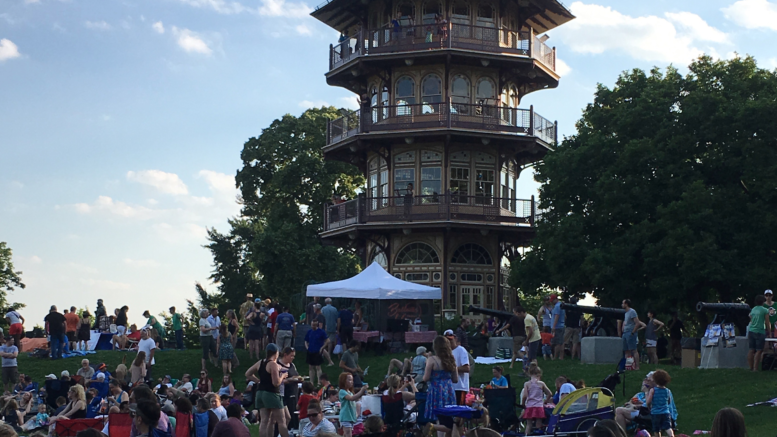
I would like to reserve Patterson Park Pavilion 1 for rent on Thursday, July 14 from 4 pm to 7 pm.